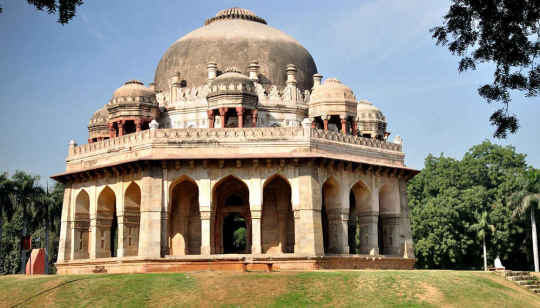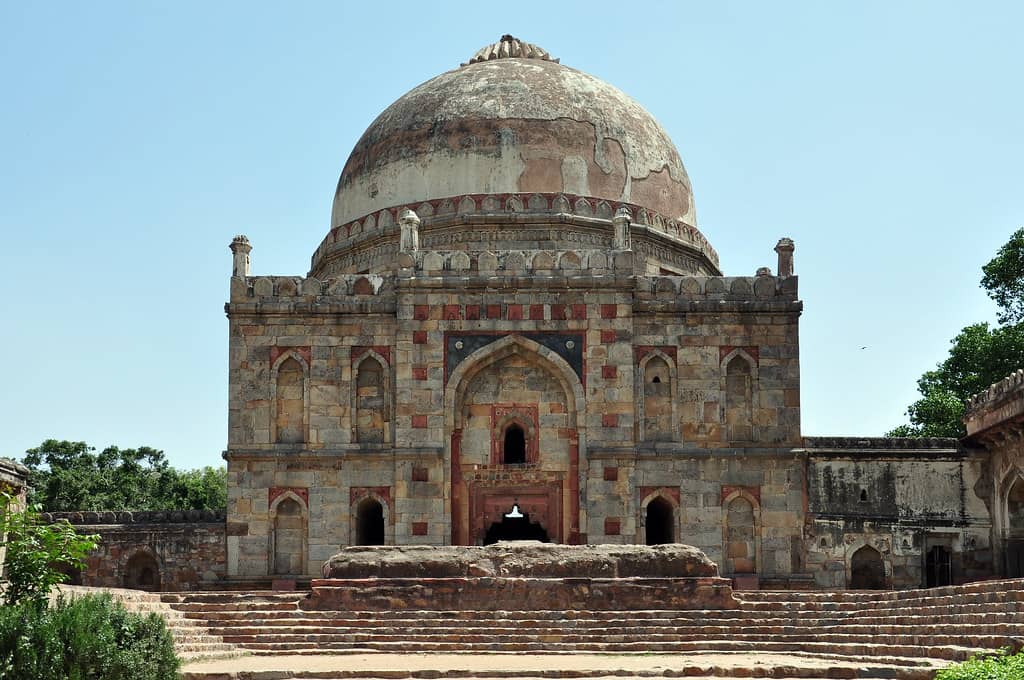The beautiful Lodhi Garden is a popular escape for many, symbolizing national, historical, and architectural values. It is an architectural marvel brought to life by the Sayyid and Lodhi dynasties that held sway over Delhi in the 16th century. But where is Lodhi Garden? Well, it is located on Lodhi Road in South Delhi between the Khan Market and Safdarjung Tomb.
It has several ancient structures, reflecting the glory of the bygone era. Plus, its excellent location makes it a wonderful picnic location for families. The magnificent park spans over 90 acres, featuring stunning structures and graves. Famous Bollywood films like Lakshya, Fanaa, and more were shot here.
Lodhi Garden Delhi – Timing, Structure & Attractions
How to Get to Lodhi Garden Delhi
Lodhi Gardens is nestled in the heart of Delhi. So, it is easily accessible from across the city.
By Air: The Indira Gandhi International Airport is close to the Lodhi Garden, and we may get there by bus or taxi. From here, transportation will be quick and easy.
By Metro: You can get to Lodhi Gardens by road and metro. The Lodhi Garden’s nearest metro station is the Jor Bagh metro station, just 1.1 km away. It is on the Yellow Line. Just 1.4 km away, the other nearby metro station is the JLN metro station on the Violet Line. Feel free to access the landmark by state-run and private buses, auto-rickshaws, and taxis.
By Bus: The buses to Lodhi Garden include 522CL, 522A,440, 615 and 794.
Lodhi Garden Timing for Summer & Winter
| Location | Lodhi Estate |
| Area | 364217 Square Meter |
| Summer Timings [ April to Sept] | 5:00 am to 8 pm |
| Winter Timings [Oct to March] | 6:00 am to 8:00 pm |
| Entree Fee | Free |
| Nearest Metro Station | Jorbagh Metro Station & Lok Kalyan Marg Metro Station |
If you wish to avoid the searing heat of the city, the months of October to March are ideal. The seasons of spring and winter are perfect for sightseeing. The visit should be avoided entirely between April and June when temperatures often surpass 40 degrees Celsius. The weather may be extremely variable from July to September during the monsoons. It may rain hard or not at all. And it may become steamy and sweaty at times.
History of Lodhi Gardens

Ala-ud-din Alam Shah erected the first monument in the garden, the Mausoleum of Mohammed Shah, in 1444. It was constructed in loving remembrance of Mohammed Shah, the then-ruler of the country. Lodhi Garden has got medieval influence in its architecture only from these two. It is regarded as a significant preservation site.
During Akbar’s reign, the Garden was renovated to serve as an observatory and a site for a library to preserve the documents. The graves were constructed in woods, but by the twentieth century, the region had become a settlement, and the tombs were repurposed as houses. It was designated as a public garden in 1936, and some species are now labeled. Initially named after Lady Wellington, the Lodhi Garden was created to conserve and maintain the Lodi-era graves as a tourist spot.
Lodhi Gardens’ Structure

It is home to over a hundred different tree species and over fifty different uncommon birds and insects. More than a dozen magnificent Mughal structures from the 15th century may be seen inside the Lodhi Garden. Mohammed Shah’s tomb, the twin tombs of Sheesh Gumbad and Bada Gumbad, the Greenhouse, and Sikander Lodi’s walled mausoleum are the noteworthy monuments in the Lodhi Garden. The building here is a blend of Sayyid and Lodhi architecture. The Archaeological Survey of India is now looking after this location.
Mohammad Sayyid’s Tomb

Mohammad Shah’s mausoleum, the final king of the Sayyid Dynasty, is one of the oldest tombs here. Ala-ud-din Alam Shah erected this cenotaph in 1444 as a memorial to the leader. His mausoleum is built with a mix of Hindu symbolism and Islamic motifs.
The tomb’s main complex is octagonal, with a central dome adorned with three arches, verandahs, and old defensive features. This tomb may also be viewed from the road. It features a room in the center surrounded by a verandah. The sculptures on the domes and the crowning lotus are noteworthy. It has eight tombs, one of which is claimed to be Muhammad Shah’s.
Bara Gumbad

The Bara Gumbad, a huge rubble dome, is located centrally in the Delhi Lodhi Garden. However, it isn’t a tomb but rather a passageway to a nearby three-domed mosque. Both were erected in 1494 in Sikander Lodi’s reign. The Bada Gumbad is U-shaped, with the dome embarked in the south. The mosque is on the west side, while an expansive assembly hall occupies the east side.
The three structures are all elevated on a high plinth, accessible from the south side by a wide flight of stairs. In the center, there is a spacious open courtyard. A square sandstone framework supports the enormous dome of the Bara Gumbad. Bada Gumbad’s front has recessed arches with black and red stone traces. The construction appears to be two floors from the outside. However, it has just one floor.
On the northwest corner sits a modest mosque. Some historians believe the Bada Gumbad was erected as a doorway to the mosque, although it is commonly thought of as a distinctive tomb. Unfortunately, the tomb’s occupant cannot be recognized, although he must have been a high-ranking commander during Sikandar Lodi’s reign (1489–1517). A five-arched entry leads to the three-domed mosque from the east. The central arch is the biggest of the five, and its size decreases as one goes out from the center.
The mosque’s interiors, built in 1494, are beautifully adorned with stuccoes and frescoes with floral, and geometric motifs and Quranic inscriptions. The narrow pillars on the rear corners and jharokha (oriel) windows make the structure more impressive.
Sikandar Lodhi’s Tomb

Sikander Lodhi’s mausoleum is modeled after Shah’s tomb and is an excellent example of this construction style. Even now, the battlements may be found in this tomb.
Sheesh, Gumbad/Glass Dome
The Glass Dome, standing opposite the Bara Gumbad, got its name from the glazed tiles used in its construction. Plasterwork with Quranic calligraphy adorns the ceiling, which is a depiction of both Hindu and Islamic architecture. Surprisingly, the Glass Dome houses the skeletons of an unknown family. This was also built under Sikander Lodi’s reign.
Water Tank
Once within the Lodhi Gardens, you may observe the ruins of a stream that connects Sikander Lodi’s tomb to the Yamuna River.
8 Pier Bridge
Look for the Athpula, an eight-pierced bridge spanning a tiny lake. Also, an eight-pier bridge near Sikander’s tomb was built by Mughal Emperor Akbar. It features seven enormous arches, the central one being the biggest and most attractive.
Attractions in the vicinity
Near the Lodhi Gardens, there are several opportunities for sightseeing and tasting Delhi’s native cuisines. The India International Centre, located approximately 500 meters from the Lodhi Garden, is a cultural center that hosts various events and seminars. Besides that, Khan Market, the Humayun’s Tomb, and the Lodhi Estate are worth visiting.
Tips
Keeping a few things in mind before visiting will make the visit seamless.
- Most of the year, Delhi experiences intense temperatures. Bring a hat or scarf to shield yourself from the sun’s strong beams.
- Wear comfortable shoes if you intend to jog about the garden.
- Staying hydrated is necessary during the entire visit.
- If you like reading, bring a book and set out early in the early morning Photography is a must.
Little known facts
A few unique facts make the Lodhi Gardens in Delhi even more intriguing.
- One of the British-era gates is still in service.
- The New Delhi Municipal Council has attached QR tags to 100 different tree types to discourage people from chopping down garden trees.
Conclusion
Lodi Gardens Delhi is a fantastic spot to spend time in a historic environment. After you’ve had your fill of the attractions, proceed to a heartfelt shopping or treat your tastebuds. The garden and the structures reflect the national capital’s famous tryst with history, boasting outstanding architecture and exquisite natural beauty. It provides both entertainment and education. There are several hotels nearby Lodhi Garden. From joggers to history buffs, the garden attracts them all.
People are also reading:




